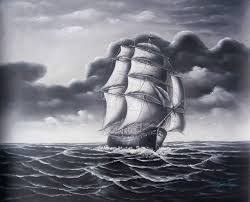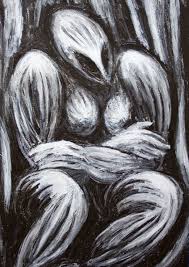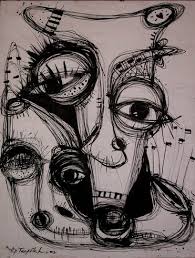Source:- Google.com.pk
Black And White Paintings Biography
Franz Jozef Kline (May 23, 1910 – May 13, 1962) was an American painter mainly associated with the Abstract Expressionist movement centered around New York in the 1940s and 1950s. He was born in Wilkes-Barre, Pennsylvania, and attended Girard College, an academy in Philadelphia for fatherless boys. He attended Boston University, spent summers from 1956-62 painting in Provincetown, Massachusetts, and died in New York City of a rheumatic heart disease. He was married to Elizabeth Vincent Parsons, a British ballet dancer.
Contents [hide]
1 Career
2 Black and white and color
3 See also
4 References
5 Further reading
6 External links
[edit]Career
As with Jackson Pollock and other Abstract Expressionists, he was labeled an "action painter" because of his seemingly spontaneous and intense style, focusing less, or not at all, on figures or imagery, but on the actual brush strokes and use of canvas. For most of Kline's [mature and representative] work, however, as the phrase goes, "spontaneity is practiced". He would prepare many draft sketches – notably, commonly on refuse telephone book pages – before going to make his "spontaneous" work.
[edit]Black and white and color
High Street, 1950, Harvard Art Museums/Fogg Museum
Kline's best known abstract expressionist paintings are in black and white. Kline re-introduced color into his paintings around 1955, though he used color more consistently after 1959. Kline's paintings are deceptively subtle. While generally his paintings have a dynamic, spontaneous and dramatic impact, Kline often closely referred to his compositional drawings. Kline carefully rendered many of his most complex pictures from studies. There seem to be references to Japanese calligraphy in Kline's black and white paintings, although he always denied that connection. Bridges, tunnels, buildings, engines, railroads and other architectural and industrial icons are often suggested as imagery informing Kline's work.
Kline's most recognizable method/style derives from a suggestion made to him by his friend Willem De Kooning. In 1948, de Kooning suggested to an artistically frustrated Kline to bring in a sketch and project it with a Bell Opticon opaque projector he had at his studio. Kline described the projection as such:
"A four by five inch black drawing of a rocking chair...loomed in gigantic black strokes which eradicated any image, the strokes expanding as entities in themselves, unrelated to any entity but that of their own existence."
Kline created paintings in the style of what he saw that day throughout his life. In 1950, he exhibited many works in this style at the Charles Egan Gallery.








Black And White Paintings Biography
Franz Jozef Kline (May 23, 1910 – May 13, 1962) was an American painter mainly associated with the Abstract Expressionist movement centered around New York in the 1940s and 1950s. He was born in Wilkes-Barre, Pennsylvania, and attended Girard College, an academy in Philadelphia for fatherless boys. He attended Boston University, spent summers from 1956-62 painting in Provincetown, Massachusetts, and died in New York City of a rheumatic heart disease. He was married to Elizabeth Vincent Parsons, a British ballet dancer.
Contents [hide]
1 Career
2 Black and white and color
3 See also
4 References
5 Further reading
6 External links
[edit]Career
As with Jackson Pollock and other Abstract Expressionists, he was labeled an "action painter" because of his seemingly spontaneous and intense style, focusing less, or not at all, on figures or imagery, but on the actual brush strokes and use of canvas. For most of Kline's [mature and representative] work, however, as the phrase goes, "spontaneity is practiced". He would prepare many draft sketches – notably, commonly on refuse telephone book pages – before going to make his "spontaneous" work.
[edit]Black and white and color
High Street, 1950, Harvard Art Museums/Fogg Museum
Kline's best known abstract expressionist paintings are in black and white. Kline re-introduced color into his paintings around 1955, though he used color more consistently after 1959. Kline's paintings are deceptively subtle. While generally his paintings have a dynamic, spontaneous and dramatic impact, Kline often closely referred to his compositional drawings. Kline carefully rendered many of his most complex pictures from studies. There seem to be references to Japanese calligraphy in Kline's black and white paintings, although he always denied that connection. Bridges, tunnels, buildings, engines, railroads and other architectural and industrial icons are often suggested as imagery informing Kline's work.
Kline's most recognizable method/style derives from a suggestion made to him by his friend Willem De Kooning. In 1948, de Kooning suggested to an artistically frustrated Kline to bring in a sketch and project it with a Bell Opticon opaque projector he had at his studio. Kline described the projection as such:
"A four by five inch black drawing of a rocking chair...loomed in gigantic black strokes which eradicated any image, the strokes expanding as entities in themselves, unrelated to any entity but that of their own existence."
Kline created paintings in the style of what he saw that day throughout his life. In 1950, he exhibited many works in this style at the Charles Egan Gallery.
Black And White Paintings
Black And White Paintings
Black And White Paintings
Black And White Paintings
Black And White Paintings
Black And White Paintings
Black And White Paintings
Black And White Paintings
Black And White Paintings
Black-And-White Paintings
Painting: Black And White Paintings
No comments:
Post a Comment